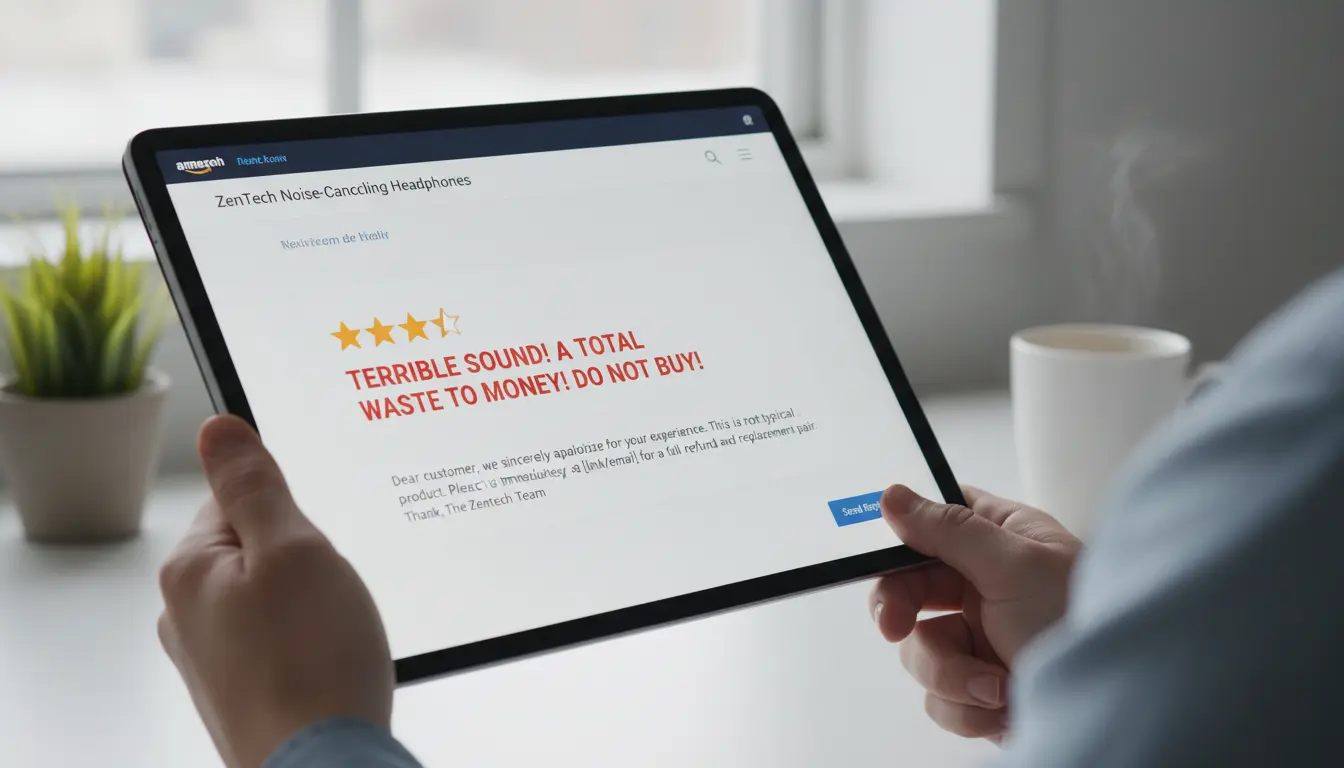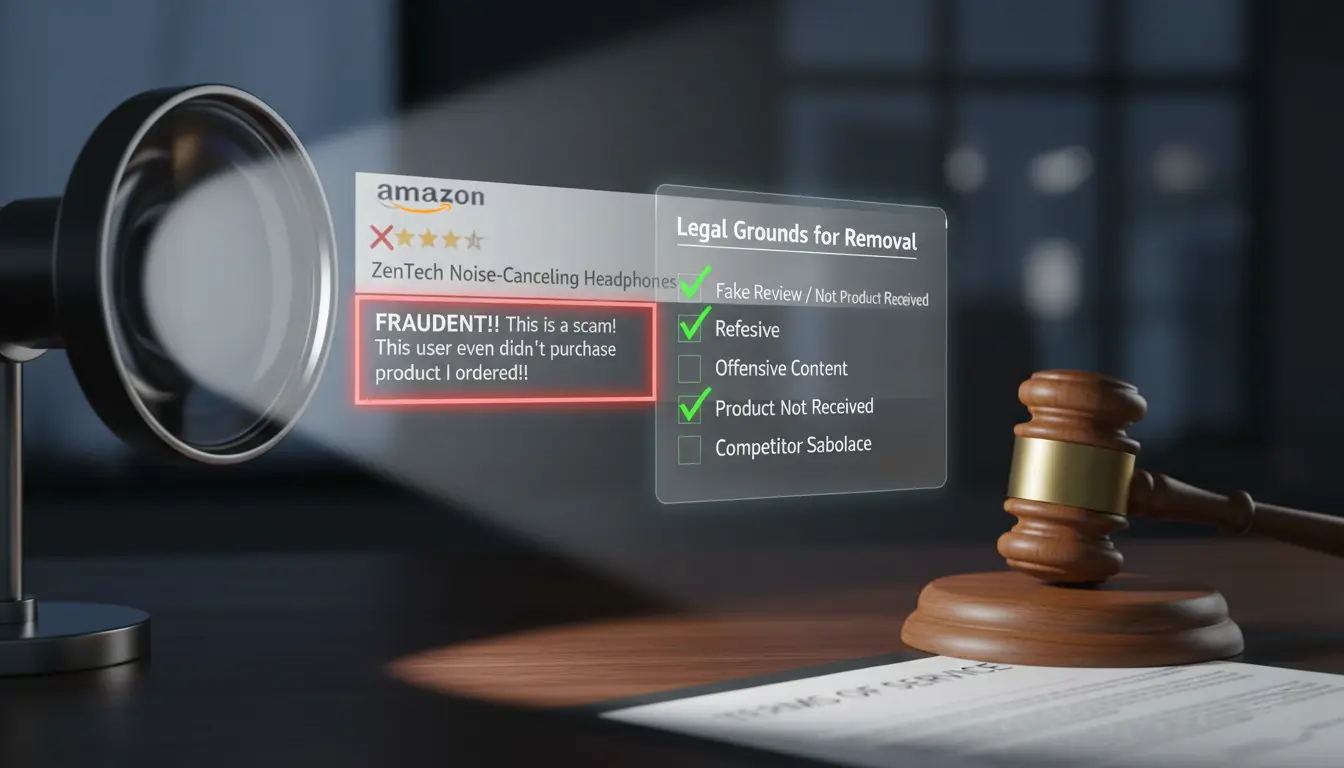TABLE OF CONTENTS
Why Customers Leave Negative Reviews
Product Quality or Performance
Impact of Negative Reviews on Your Amazon Business
Your Ranking Drops in Amazon Search
It Damages Your Brand’s First Impression
You Miss Out on Valuable Insights
How to Monitor and Analyze Reviews Effectively
Track Trends, Not Just Individual Comments
Build a Simple Review Dashboard
How to Respond to Negative Reviews Professionally and Promptly
How to Prevent Negative Reviews Before They Happen
Selling on Amazon has huge potential, but it also exposes your brand to public feedback daily. No matter how much effort you put into product quality or customer service, just bear in mind that negative reviews are inevitable. Every seller receives them at some point.
It’s true that a one-star rating can feel very discouraging, especially when you know how much work goes into every order. Still, these reviews are important. They reflect real experiences, real expectations, and sometimes, factual misunderstandings.
What matters most is how you handle them. Responding quickly and professionally can turn a poor experience into a second chance, not just with the customer who left the review, but with everyone else reading it. In many cases, your reaction does more to shape your reputation than the review itself.
Which is why, in this article, we’ll explain how to deal with negative reviews on Amazon in a structured and practical way. You’ll learn:
- Why customers leave bad reviews
- The impact these reviews have on your visibility and sales
- How to respond effectively
We’ll also explain what can and can’t be removed under Amazon’s rules, and steps to reduce future complaints using better communication, packaging, and listing clarity.
Let’s get right in.
Why Customers Leave Negative Reviews
You must realize that most Amazon negative reviews aren’t written out of frustration alone; they’re a form of feedback. When something doesn’t meet your customer’s expectations, writing and sending a review becomes their way of being heard.
Understanding why customers leave negative reviews helps you identify areas for improvement and prevent similar issues in the future.
Below are some of the reasons:
Product Quality or Performance
The most common reason your customers leave negative reviews is that the product doesn’t work as described. Sometimes, a part might break easily, a size might not match the listing, or the quality might feel below expectations. Any tiny discrepancy between what’s promised and what’s delivered can lead to disappointment.
Shipping or Delivery Problems
Late deliveries, damaged packaging, or missing items are also causes of negative feedback. Although we know that these issues are usually outside a seller’s direct control, customers usually associate the experience with the brand, not the logistics provider. This is why clear communication and proactive updates are very important when it comes to managing expectations.
Wrong or Incomplete Orders
Sending the wrong colour, size, or model can quickly trigger frustration. These mistakes are usually operational, but you can easily avoid them through tighter fulfilment checks and accurate product labelling.
Customer Service Issues
Sometimes, it’s not the product that causes a bad review, it’s how a complaint is handled. When you delay responses or send generic replies, it can make your customers feel ignored. This is why fast, polite, and solution-focused support often prevents negative feedback before it’s even posted.
Unmet Expectations
Occasionally, there’s no apparent fault, just a mismatch between what the buyer expected and what they received. This can happen with subjective factors like “comfort,” “fit,” or “durability.” To avoid this mismatch, clearly communicate your product benefits and use honest visuals to help reduce the gap between perception and reality.
Impact of Negative Reviews on Your Amazon Business

Every Amazon seller would agree that bad reviews are not just about reputation; they affect almost every part of your sales performance.
Here’s how:
You Lose Shoppers
If someone searches for “wireless earbuds” and sees two listings, both priced the same and both with professional photos. One has an average rating of 4.8 stars. The other shows 3.9 with a few recent one-star comments.
Which one do you think they’ll click? The one with the higher rating.
Customers make decisions quickly, and many times, they don’t even give a lower-rated product a chance. It’s not always fair, but perception drives clicks, and clicks drive sales.
Your Ranking Drops in Amazon Search
Amazon wants to showcase products that sell well and leave customers happy. If your recent reviews are negative, your product’s performance score will reduce, and your visibility in search results will drop.
It’s simple: fewer positive reviews → lower click-through → fewer conversions → reduced visibility.
The reviews you receive act as signals to Amazon’s algorithm, saying, “This product delivers what it promises.” When those signals become negative, your listing quickly loses its score.
You Risk Losing the Buy Box
If you’re new to selling on Amazon, the Buy Box is the section on your product page that has the bright yellow “Add to Cart” button. When multiple sellers offer the same product, Amazon determines which seller “owns” that box, and that seller gets the sale when customers click.
Amazon doesn’t hand out the Buy Box randomly. It’s based on performance (fast delivery, competitive pricing, and most importantly, customer satisfaction). When your store starts receiving negative reviews about slow shipping, damaged items, or unhelpful support, Amazon sees that as a red flag.
The algorithm assumes a poor buying experience, and another seller with stronger reviews or fewer complaints might take your spot. You might still appear under “Other Sellers,” but shoppers rarely scroll down that far.
It Damages Your Brand’s First Impression
You’ve probably done it yourself: scrolling through reviews before buying, jumping straight to the one-star section to see the “worst-case scenario.” This is because people want to know what could go wrong.
When they see unresolved complaints or angry comments without your response, they assume you don’t care. But if they see you replying politely, they’ll see you as a brand that cares.
Example:
“We’re sorry your water bottle arrived dented. We’ve sent a free replacement and reported the issue to our courier. Thank you for bringing it to our attention.”
That kind of calm, helpful response shows you’re a real business that listens. Many customers will overlook a few bad reviews if they see professional, solution-focused communication.
You Miss Out on Valuable Insights
Every negative review is a clue, an opportunity for you to improve your brand. Maybe customers keep mentioning that the packaging feels cheap or that the Amazon product description doesn’t match what arrives in the box.
If you read between the lines, you’ll find patterns that point directly to what’s limiting your growth. For example, if several people say “the colour looks different from the photo,” that’s your sign to update your images. If they mention late delivery, it’s time to double-check your fulfilment setup.
How to Monitor and Analyze Reviews Effectively

Reviews are like real-time feedback from customers who are telling you exactly what’s working and what’s not. The trick for every Amazon seller is to catch those signals early and act before small problems start affecting your ratings.
You can monitor and analyze your reviews effectively through the following ways:
Use Tools to Save Time
Manually reading reviews is fine when you’re starting out, but as your catalogue grows, we recommend you use tools to make your life easier. Tools like AMZScout AI Review Analyzer, Jungle Scout, and FeedbackWhiz can automatically categorize reviews by topic or sentiment.
For example:
- “Packaging” mentioned 14 times (mostly negative)
- “Quality” mentioned 26 times (positive)
- “Instructions” mentioned 7 times (neutral)
That kind of breakdown helps you identify what consistently frustrates customers and what they already love.
Track Trends, Not Just Individual Comments
One or two bad reviews won’t ultimately kill your visibility. But if you notice the same complaint repeating, that’s a signal. If customers keep saying “the colour looks different than in the photo”, then that’s a cue to adjust your Amazon product images. Also, if several people mention “arrived damaged”, it’s time to revisit your packaging or fulfillment setup.
Reviews give you free market research. They’re often more honest and specific than what you’d get from surveys or paid feedback.
Watch Your Competitors Too
Don’t limit your review monitoring to your own listings. Take a look at what buyers are saying about your competitors’ products.
You’ll often spot patterns that can help you stay ahead. If customers keep complaining that a rival’s product “doesn’t hold a charge,” make sure you highlight battery life as a key benefit in your bullet points or description.
Build a Simple Review Dashboard
You don’t need anything fancy; even a spreadsheet works. Create columns for:
- Review date
- Star rating
- Topic (e.g delivery, packaging, performance)
- Notes or action items
Over time, this provides a clear picture of how your customer sentiment changes as you update your listings or fix known issues.
How to Respond to Negative Reviews Professionally and Promptly

Knowing how to respond to a negative review on Amazon is one of the surest ways to turn a critic into a repeat customer.
Here’s how to handle it like a professional:
- Stay calm and read carefully: Avoid taking it personally. Look for the main issue behind the emotion
- Reply publicly when appropriate: You can post a comment beneath the review to thank the customer for their feedback and explain that you’re addressing the problem. This shows other shoppers that you care
- Take the conversation offline: If the issue involves private details, reach out through Amazon’s buyer–seller messaging system. Offer a replacement, refund, or solution within Amazon’s rules
- Keep it short, polite, and solution-focused: For instance, you can say something like: “We’re sorry your order arrived late. We’ve reported the delay to our carrier and processed a refund. Thank you for helping us improve.”
- Avoid arguments: Remember, defensiveness always backfires. Let your professionalism speak for your brand
P.S: A timely, respectful reply does more for your reputation than a five-star review.
Legal Ways to Remove Reviews

If you’re wondering how to delete a negative review on Amazon, then keep reading. In most cases, you can’t, but there are legitimate ways to request removal when a review violates Amazon’s guidelines.
Amazon will consider removal if a review:
- Contains offensive or abusive language
- Mentions unrelated products or sellers
- Reveals personal information
- Is a seller-feedback comment posted in the product review section
To report it:
1. Go to the review, click the “Report abuse” link, and choose the relevant reason.
2. If it clearly violates policy, open a case in Seller Central with screenshots and context.
So, does Amazon remove negative reviews? Yes, but only when they break the rules. For genuine customer opinions, even harsh ones, the best approach is to respond professionally and improve what you can control.
But many times, prevention is better.
How to Prevent Negative Reviews Before They Happen

Good prevention will always beat damage control. Take a quick look at some habits that reduce your chances of bad feedback:
- Quality control: Inspect batches regularly, and test new shipments before they reach customers
- Accurate listings: Use clear photos, correct measurements, and honest Amazon product descriptions to keep your expectations realistic
- Packaging improvements: Use sturdy, branded packaging as they protect your products and also create a premium unboxing experience
- Reliable fulfillment: Use FBA (Fulfillment By Amazon) when possible to minimize late or damaged deliveries
- Proactive communication: Send clear shipping updates and thank-you notes through Amazon’s approved messaging
The fewer surprises your customers experience, the fewer complaints you’ll need to resolve.
Encouraging Positive Feedback to Balance the Negative

You can’t remove every bad comment, but you can dilute its effect by growing genuine positive ones.
- Ask ethically: After a successful delivery, use Amazon’s “Request a Review” button on the Order Details page to prompt feedback
- Delight customers: Use thoughtful packaging, small thank-you cards (without incentives), and reliable support to delight your buyers
- Respond to positive reviews: A simple “Thanks for sharing your experience!” shows authenticity and keeps engagement high
- Leverage satisfied customers: If someone praises your service in a message, kindly remind them they can share that opinion publicly
With consistent positive engagement, you can balance your overall star rating and build a strong brand narrative.
Wrapping Up
It’s important that you learn how to deal with negative reviews on Amazon. Instead of viewing criticism as failure, treat it as free insight into how customers experience your product and brand.
Handle every complaint with calm professionalism, address underlying issues, and continue to build trust through consistent service. Over time, your transparency will outweigh the occasional bad review, and shoppers will remember how you responded, not just what went wrong.
FAQs
1. What Counts As A Negative Review On Amazon?
Any review rated one to three stars, or any comment that criticizes product quality, delivery, or service, is typically considered negative feedback.
2. How Often Should I Monitor My Amazon Reviews?
Check daily, or at least several times per week. Fast responses matter, both for customer satisfaction and Amazon's performance metrics.
3. Can Sellers Respond Publicly To Negative Reviews On Amazon?
Yes. You can post a public comment under the review to acknowledge the issue. Keep your tone professional and avoid discussing order details publicly.
4. Does Amazon Remove Negative Reviews?
Only if they violate community or content guidelines. Authentic opinions, even harsh ones, cannot be removed. We recommend focusing on professional replies and better service instead of trying to erase feedback.






.svg)

.avif)

.svg)